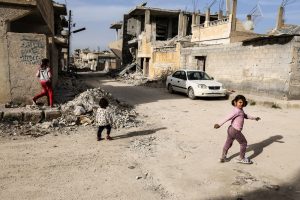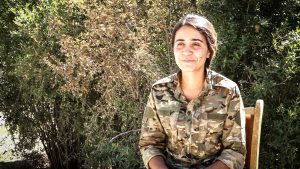The following article, written by Giacomo Sini and Alessia Manzi, was first posted by bella caledonia. It examines the role of Turkish president, Tayyip Erdoğan, in using the earthquake disaster to further undermine the persecuted Kurds, in both Turkey and Syria, and his bolstering of ISIS forces to achieve this.
NATURAL AND UNNATURAL DISASTERS IN ROJAVA, NORTH EAST SYRIA AND SOUTH EAST TURKEY

“These things have always happened. They are part of fate’s plan.” [1]
This is how Turkish President Recep Tayyip Erdoğan commented on the devastating earthquake that struck southern Turkey and northwestern Syria at 4.17 a.m. on Monday, 6 February, killing more than 50,000 people, along with thousands injured and displaced. “Out of 170,000 buildings analyzed, at least 24,921 are uninhabitable or damaged,” said Environment Minister Murat Kurum [2], as the death toll continues to rise and Erdoğan tries to bury his responsibility. Coming into the crosshairs of the accusations is the 2018 building amnesty, whereby buildings were built contrary to earthquake-resistant regulations. “Since the first days, the state has blocked NGOs and opposition parties that were bringing aid here in Adiyaman,” says Ahmet Türk [3], a Kurdish politician from the HDP (Peoples’ Democratic Party), who has been on one of the sites that, together with Hatay and Gaziantep provinces, has suffered the worst damage for days. “For two days there was no rescue and people were left under the rubble. This is the biggest disaster,” Türk concludes. “Eighty per cent of the city no longer exists.

Some kids walking in the streets of Kobane, shortly after the liberation of the city from ISIS. 2015 credit: Giacomo Sini
In some neighborhoods, people were without electricity for three or four days. It is very cold”, says Sait Dede, HDP deputy [4]. Just in Adiyaman, a rescue team of Spanish firefighters said they saw government bulldozers knocking down buildings, heedless of the people under the rubble. [5]
“Erdoğan has emptied state institutions, placed loyalists in key positions and wiped out most civil society organizations, enriching the elite around him. The culmination of all these things came with the earthquake”, says Gonül Tol [6], director and founder of the Turkey studies for the Middle East Institute. In the days following the natural disaster, some media, activists and civil society organizations tried to denounce the inefficiency of the government’s emergency plan, while lot of volunteer rescue teams suffered detentions and humanitarian aids some threats from Turkish law enforcement.[7]
This did nothing to conceal the failed choices of the government led by the AKP (Justice and Development Party); founded by the president himself 20 years ago and then in the country’s governing majority. A political leadership that in the space of two decades has led Turkey down the way of a strong economic and social retrogression. The next general elections were supposed to be held in May, but the earthquake will probably lead to their postponement. Erdoğan, with a victorious outcome in the balance, shortly before the earthquake, was aiming for victory by fueling the anti-Kurdish sentiment of the majority of his voting stronghold. “Inflation, steadily rising economic unemployment threaten Erdogan’s stability, what better distraction, if not war?” comments Mezlom Kobane, commander-in-chief of the SDF (Syrian Democratic Forces), which controls several territories in northern Syria, badly hit by the recent earthquake and under constant attack by Turkey, despite it.
Although the inflation rate on food reached 90 per cent in September [8] and around 30 million inhabitants live in poverty [9]– to which one and a half million people are now homeless [10]- Erdoğan’s government ranks 20th among countries that buy weapons from the European Union and has invested EUR 20.4 billion in military spending in 2019. [11]

A large part of the Turkish army’s armaments is used in the repeated attacks on the Kurdish region of Northern Syria. Saleh Mislim, a citizen of Kobane – a city in Turkey’s sights and a symbol of Kurdish resistance against ISIS – has been living for years under constant threat of bombings, attacks and the risk of a new invasion.
“Since the 2011 revolution, the Turkish state has never stopped its war against the Kurds. At one time it did not use its own soldiers, but supported Isis aggression and, before that, flanked Qaedist forces such as Al-Nusra and Arhar al Sham”.
After the defeat of the Islamic State, “Turkey crossed the border through open warfare in the AANES (Autonomous Administration of Northern and Eastern Syria) territories”, Saleh angrily recalls. The connection between Turkey and forces linked to jihadist groups is also demonstrated during this dramatic situation.
For several days, Turkey and the Syrian rebel factions linked to it, did not allowed in trucks loaded with humanitarian aid sent by AANES to the Afrin canton, occupied by Ankara and its Syrian allies since 2018 with Operation Olive Branch. The earthquake was also severely felt in Afrin canton. Here, one of the hardest hit towns is Jinderis; with 1,200 dead and over 100,000 displaced. A few hours after the strong tremor that shocked the Middle East, the Turkish army hit Tel Rifaat, in the Shahba district, with artillery. This attack was followed by others with drones and heavy weapons along the M4 highway and in the countryside of Ain Issa and in Kobane, where an elderly man was killed and a man was severely injured. The latest aggression is part of a framework of attacks that Turkey has been launching on North and East Syria since 2016, through a low-intensity war and a series of military operations, such as Operation Peace Spring (2019), ended with peace agreements between the US and Turkey that were never fulfilled. This was followed by Claw-Sward, which last November attempted to invade Kobane. “Vital infrastructure such as power plants, oil fields, grain silos, medical stations and schools were targeted,” says Dilan Kobane, a YPJ (Women’s Protection Unit) fighter, “the Turkish state, despite being an active participant in the Syrian conflict since 2015, supports the rebuilding of Isis in every way”.
During the last military campaign, Erdoğan attacked the Asayîş – Internal Security Forces, tasked with securing the Al- Hol camp, home to 54,000 people ideologically linked to the Islamic State. During the attack eight fighters were killed. “Where are now the US and Coalition forces who said the camp is dangerous for the whole world? Those who play a shield role on behalf of the international community to inhibit the expansion of the ISIS threat are being bombed by Turkey. How can NATO allow one of its members to attack those who have been fighting ISIS for 11 years?” says Dilbirîn Kobane, commander of the YPJ in the Cizire canton.

One of the streets of Kobane shortly after the liberation of the city from Isis. The city was destroyed by 80% from fights and bombings. 2015 Credit: Giacomo Sini
“The war will allow the Islamic State to regain strength. If there is anything we are responsible for, it is protecting the population from imminent massacres”, Dilbirîn comments. “We felt responsible for the whole world, that’s why we fought the Islamic State and continue to do so”, Kobane urges in a firm voice. “With the recent attacks, we notice a coordination between Turkey and ISIS. We have obtained information about this”, continues Dilovan Kobane.
“We can therefore say that one of Turkey’s goals is to strengthen ISIS in our regions, using it as a card to play against us”, says Dilovan. In Al- Hol, the first part of the Humanity & Security operation conducted by the SDF (which also includes the YPJ) was carried out in 2021.
“In recent years, the YPJ have made huge sacrifices to protect the world from the obscurantism of Isis. Once and for all, we want to defeat this enemy from our lands, so that it cannot spread elsewhere” the fighter says. The operation led to the arrest of 121 ISIS secret cells. In addition to it, tons of TNT, tents used to train new recruits, weapons and electronic devices were seized. “We also found Turkish military uniforms,” says the fighter. “The operation started late because Turkish attacks hit constantly our regions,” concludes Dilovan.
“During this time, the Free Syrian Army and Turkey will take advantage of the situation to seize the city and the property of the Kurds”, denounces SOHR (Syrian Observatory for Human Rights) looking at the city of Jinderis, where 90 per cent of the buildings are destroyed or unusable. The earthquake has forced the population to leave their homes once again. An estimated 3,000 families have reached the neighboring canton of Shahba, where 200,000 people have already been displaced from Afrin and where, according to ECDC – European Centre for Disease Prevention, the cholera epidemic – that has already been going on for months – will worsen in two to four weeks. In addition to Turkey, the Kurdish population is also being threatened by the government in Damascus.
In Sheikh Masquoud and Ashrafiyah, Kurdish neighborhoods north of Aleppo, the arrival of humanitarian aid has been slowed down by the embargo imposed by the Damascus government to it, which Assad sometimes breaks after long negotiations.
“Over the past year, the Damascus government has deprived the Sheikh Maqsoud neighborhood of medicines, fuel,” reports SOHR. The neighborhood has been the scene of clashes between its self-defence militias linked to AANES and the Fourth Division, a militia led by Maher Assad, the younger brother of Bashar Al Assad, and supported by Iran. “In January, just before the earthquake, there had been no fuel for 50 days and people could not have electricity for more than an hour a day” the Observatory says, While digging continues under the rubble in Kurdistan.
2.3.23
[1] https://www.bbc.com/news/world-europe-64594349
[2] https://www.politico.eu/article/turkey-cracks-down-on-contractors-of-quake-struck-buildings/
[4] https://anfenglish.com/kurdistan/hdp-mp-dede-earthquake-left-80-percent-of-adiyaman-devastated-65567
[6] https://foreignpolicy.com/2023/02/13/turkey-syria-earthquake-erdogan-elections-negligence/
[7] https://ipi.media/turkey-must-allow-independent-media-coverage-of-tragic-earthquake-aftermath/
_____________
also see:
Earthquake in Turkey: the state versus the people – Sarah Glynn, bella caledonia
Chere Marianne: do you know why the Kurds are angry? – Sarah Glynn, bella caledonia
Turkey makes ready to destroy Rojava – Sarah Glynn, bella caledonia
